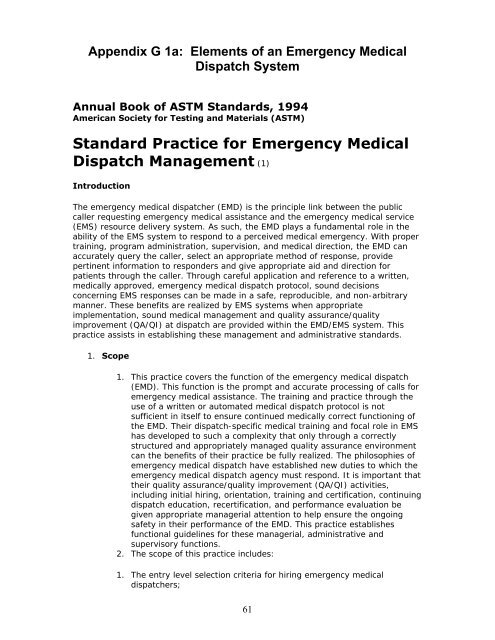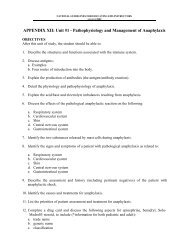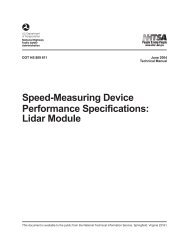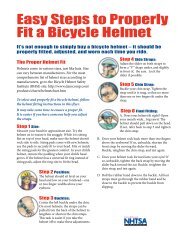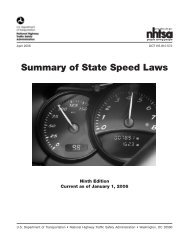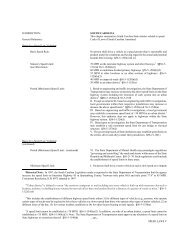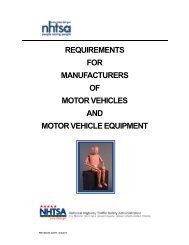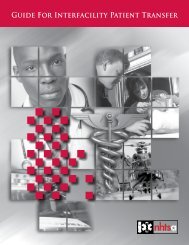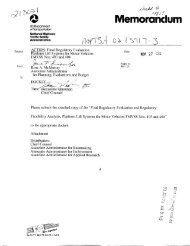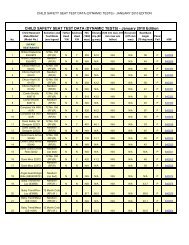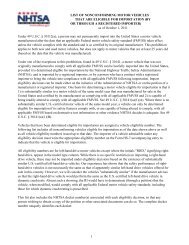Standard Practice for Emergency Medical Dispatch ... - NHTSA
Standard Practice for Emergency Medical Dispatch ... - NHTSA
Standard Practice for Emergency Medical Dispatch ... - NHTSA
You also want an ePaper? Increase the reach of your titles
YUMPU automatically turns print PDFs into web optimized ePapers that Google loves.
Appendix G 1a: Elements of an <strong>Emergency</strong> <strong>Medical</strong><br />
<strong>Dispatch</strong> System<br />
Annual Book of ASTM <strong>Standard</strong>s, 1994<br />
American Society <strong>for</strong> Testing and Materials (ASTM)<br />
<strong>Standard</strong> <strong>Practice</strong> <strong>for</strong> <strong>Emergency</strong> <strong>Medical</strong><br />
<strong>Dispatch</strong> Management (1)<br />
Introduction<br />
The emergency medical dispatcher (EMD) is the principle link between the public<br />
caller requesting emergency medical assistance and the emergency medical service<br />
(EMS) resource delivery system. As such, the EMD plays a fundamental role in the<br />
ability of the EMS system to respond to a perceived medical emergency. With proper<br />
training, program administration, supervision, and medical direction, the EMD can<br />
accurately query the caller, select an appropriate method of response, provide<br />
pertinent in<strong>for</strong>mation to responders and give appropriate aid and direction <strong>for</strong><br />
patients through the caller. Through careful application and reference to a written,<br />
medically approved, emergency medical dispatch protocol, sound decisions<br />
concerning EMS responses can be made in a safe, reproducible, and non-arbitrary<br />
manner. These benefits are realized by EMS systems when appropriate<br />
implementation, sound medical management and quality assurance/quality<br />
improvement (QA/QI) at dispatch are provided within the EMD/EMS system. This<br />
practice assists in establishing these management and administrative standards.<br />
1. Scope<br />
1. This practice covers the function of the emergency medical dispatch<br />
(EMD). This function is the prompt and accurate processing of calls <strong>for</strong><br />
emergency medical assistance. The training and practice through the<br />
use of a written or automated medical dispatch protocol is not<br />
sufficient in itself to ensure continued medically correct functioning of<br />
the EMD. Their dispatch-specific medical training and focal role in EMS<br />
has developed to such a complexity that only through a correctly<br />
structured and appropriately managed quality assurance environment<br />
can the benefits of their practice be fully realized. The philosophies of<br />
emergency medical dispatch have established new duties to which the<br />
emergency medical dispatch agency must respond. It is important that<br />
their quality assurance/quality improvement (QA/QI) activities,<br />
including initial hiring, orientation, training and certification, continuing<br />
dispatch education, recertification, and per<strong>for</strong>mance evaluation be<br />
given appropriate managerial attention to help ensure the ongoing<br />
safety in their per<strong>for</strong>mance of the EMD. This practice establishes<br />
functional guidelines <strong>for</strong> these managerial, administrative and<br />
supervisory functions.<br />
2. The scope of this practice includes:<br />
1. The entry level selection criteria <strong>for</strong> hiring emergency medical<br />
dispatchers;<br />
61
2. The orientation of new emergency medical dispatchers;<br />
3. Development of QA/QI mechanisms, management strategies and<br />
organizational structures <strong>for</strong> use within a comprehensive emergency<br />
medical dispatch system;<br />
4. Per<strong>for</strong>mance evaluation as a component of a comprehensive and<br />
ongoing quality assurance and risk management program <strong>for</strong> an<br />
emergency medical dispatch system;<br />
5. Development and provision of continuing dispatch education activities<br />
<strong>for</strong> the emergency medical dispatcher;<br />
6. Requirements <strong>for</strong> initial certification and recertification of the<br />
emergency medical dispatcher;<br />
7. Provision <strong>for</strong> comparative analysis between different EMD program<br />
approached available to the EMS community that con<strong>for</strong>m to<br />
established EMD practice standards prior to implementation of an<br />
emergency medical dispatch program; and<br />
8. Guidelines <strong>for</strong> implementation of an emergency medical dispatch<br />
program.<br />
1. This standard does not purport to address all of the safety concerns, if<br />
any, associated with its use. It is the responsibility of the user of this<br />
standard to establish appropriate safety and health practices and<br />
determine the applicability or regulatory limitations prior to use.<br />
2. Referenced Documents<br />
1. ASTM <strong>Standard</strong>s:<br />
F 1258 <strong>Practice</strong> <strong>for</strong> <strong>Emergency</strong> <strong>Medical</strong> <strong>Dispatch</strong> (2)<br />
3. Terminology<br />
F 1552 <strong>Practice</strong> <strong>for</strong> Training, Instructor Qualification, and Certification<br />
Eligibility of <strong>Emergency</strong> <strong>Medical</strong> <strong>Dispatch</strong>ers (2)<br />
1. Descriptions of Terms Specific to This <strong>Standard</strong>:<br />
1. case review template-a structured per<strong>for</strong>mance evaluation document<br />
containing all necessary input and output actions required of<br />
dispatchers that parallels the EMDs' on-line protocols, policies, and<br />
procedures related to call-taking and processing. It contains check-off<br />
lists and compliance scoring mechanisms that objectively rate the<br />
EMDs' per<strong>for</strong>mance on a single call.<br />
2. dispatch life support-the knowledge, procedures, and skills used by<br />
trained EMDs in providing care through pre-arrival instructions to<br />
callers. It consists of those BLS and ALS principles that are appropriate<br />
to application by medical dispatchers.<br />
3. emergency medical dispatch agency-any organization or a combination<br />
of organizations working cooperatively, that routinely accepts calls <strong>for</strong><br />
emergency medical assistance and facilitates the dispatch of<br />
prehospital emergency medical resources/personnel and provides<br />
medically oriented pre-arrival instructions pursuant to such requests.<br />
4. per<strong>for</strong>mance evaluation-the documented, objective, quantitative<br />
measure of an individual emergency medical dispatcher's per<strong>for</strong>mance<br />
based upon compliance to departmental protocols, policies and<br />
procedures.<br />
62
5. pre-arrival instructions-telephone-rendered, medically approved<br />
written instructions provided by trained EMDs through callers which<br />
help to provide aid to the victim and control of the situation prior to<br />
arrival of prehospital personnel.<br />
6. quality assurance/quality improvement (QA/QI)-the comprehensive<br />
program of prospectively setting standards; concurrently monitoring<br />
the per<strong>for</strong>mance of clinical, operational and personnel components;<br />
and, retrospectively improving these components in the emergency<br />
medical dispatch agency when compared with these standards.<br />
7. risk management-a sub-component of the quality assurance program<br />
designed to identify problematic situations and to assist EMS medical<br />
directors, dispatch supervisors, and EMDs in modifying practice<br />
behaviors found to be deficient by quality assessment procedures; to<br />
protect the public against incompetent practitioners; and to modify<br />
structural, resource, and protocol deficiencies that may exist in the<br />
emergency medical dispatch system.<br />
4. Summary of <strong>Practice</strong><br />
1. A comprehensive plan <strong>for</strong> managing the quality of care in an<br />
emergency medical dispatch system must include careful planning,<br />
EMD program selection, proper system implementation, employee<br />
selection, training, certification, QA/QI, per<strong>for</strong>mance evaluation,<br />
continuing dispatch education, recertification, and risk management<br />
activities. These functions must be designed and implemented to assist<br />
the medical director, dispatch supervisor, and emergency medical<br />
dispatcher in monitoring and modifying EMD per<strong>for</strong>mance found<br />
deficient by QA/QI to protect the public against incompetent<br />
practitioners, as well as modify organizational structure, resource, or<br />
protocol deficiencies that exist in the emergency medical dispatch<br />
system.<br />
1. Entry level selection-The selection and evaluation of new dispatchers<br />
must include clearly written objective standards to be adopted <strong>for</strong><br />
qualifying candidates, interviewing applicants, pre-employment<br />
aptitude and skill testing pursuant to the hiring of dispatchers.<br />
2. Orientation-A pre-planned process of events focusing on the<br />
development and acclimation of an employee who will function within<br />
the organization's standards, practices, policies, and procedures.<br />
3. Quality Assurance/Quality Improvement-Within a physician medically<br />
directed emergency medical dispatch system, the development and<br />
implementation of employee per<strong>for</strong>mance thresholds, concurrent<br />
evaluation of compliance to these thresholds through on-line<br />
supervision, retrospective evaluation of non-edited logged recordings<br />
of requests <strong>for</strong> emergency service measuring compliance with policy,<br />
practice, and procedure to validate that they are appropriate, and to<br />
correct them if found to be deficient.<br />
4. Per<strong>for</strong>mance Evaluation-Each EMD in an emergency medical dispatch<br />
agency must regularly and routinely be evaluated with respect to their<br />
adherence to policy, protocol, and procedure through the QA/QI<br />
process. This determines their con<strong>for</strong>mance to these elements and<br />
measures how this per<strong>for</strong>mance affects the efficiency and effectiveness<br />
of the emergency medical dispatch agency. The evaluation must be<br />
quantitative and qualitative.<br />
63
5. Continuing Education-Each emergency medical dispatch agency must<br />
provide <strong>for</strong> the development and implementation of a continuing<br />
dispatch education program <strong>for</strong> the benefit of their EMD personnel.<br />
This program must provide the EMD with applicable educational topics<br />
designed to enhance their general knowledge and skill in the<br />
philosophy and application of the EMD program used within the<br />
emergency medical dispatch agency.<br />
6. Risk Management-A written practice and procedure shall be<br />
established <strong>for</strong> each agency that provides guidelines <strong>for</strong> physician<br />
medical directors, EMS system administrators, agency supervisors,<br />
and/or QA/QI personnel to follow when an EMD is identified through<br />
concurrent or retrospective review. This practice and procedure shall<br />
provide guidelines <strong>for</strong> proper investigative criteria relative to the<br />
medical or administrative nature of the perceived infraction, and the<br />
proper progressive disciplinary procedure to be followed in order to<br />
provide the EMD due process.<br />
7. Certification, Recertification-All EMDs working in a medical dispatch<br />
agency shall be certified as competent in the use of the medically<br />
approved EMDPRS used within the medical dispatch center. Initial<br />
certification and recertification standards shall be established by each<br />
certifying entity associated with their EMDPRS protocols in accordance<br />
with ASTM-EMD standards that validate the individual EMD-s<br />
knowledge and competency in their use.<br />
8. Reciprocal Certification-Reciprocal certification shall be established<br />
between certifying agencies and organizations having programs that<br />
meet the standards contained in this practice.<br />
9. Registration and Maintenance of Certification Records-All certifying<br />
entities, agencies, or organizations shall maintain records <strong>for</strong> all<br />
certified individuals and shall provide documents and reports regarding<br />
testing and certification status as required by using agencies, states,<br />
or governmental units. All records shall be maintained <strong>for</strong> a minimum<br />
period of ten years from initial certification, recertification or testing of<br />
the individual.<br />
10. Revocation of Certification-This guide shall set <strong>for</strong>th guidelines <strong>for</strong><br />
assessing grounds <strong>for</strong> a possible suspension or termination of<br />
certification when questionable situations arise in EMD conduct or<br />
per<strong>for</strong>mance.<br />
11. Program Selection and Implementation-Provision <strong>for</strong> comparative<br />
analysis between different EMD program approaches available to the<br />
EMS community that con<strong>for</strong>m to established EMD practice standards.<br />
This is intended to assist the EMS administrator in the selection of the<br />
program that best suits the dispatch agency's needs from a medical,<br />
legal, and operational perspective.<br />
12. Physician <strong>Medical</strong> Director-Each emergency medical dispatch agency<br />
shall have a physician medical director, who shall assist in evaluation<br />
and review of the EMD program under consideration. The physician<br />
medical director shall approve the selected EMD program written<br />
protocol. The physician shall be responsible <strong>for</strong> all medical aspects of<br />
the EMD program. Additional responsibilities include the medical<br />
oversight of the EMD training and certification program, continuing<br />
education requirements, recertification eligibility, QA/QI and risk<br />
management functions. These responsibilities include<br />
recommendations regarding the certification and employment eligibility<br />
of individuals found to be unsafe practitioners through employee<br />
evaluation and disciplinary due process.<br />
64
5. Significance and Use<br />
1. The emergency medical dispatcher should be a specially trained<br />
telecommunicator with specific emergency medical knowledge. Many<br />
of these personnel still per<strong>for</strong>m in this role without the benefits of<br />
dispatch specific medical training and medically sound protocols. The<br />
majority per<strong>for</strong>m their duties without appropriate medical<br />
management provided through a structured quality<br />
assurance/improvement environment. Training only prepares a new<br />
EMD <strong>for</strong> correct use of the EMDPRS. It cannot ensure that it is<br />
accessed and complied with as intended. Since the EMD is now clearly<br />
defined as a pre-hospital medical professional, it is necessary to<br />
establish sound medical management processes through a multicomponent<br />
QA/QI program administered by the EMD’s agency in<br />
conjunction with the physician medical director. Prompt, correct, and<br />
appropriate patient care can be enhanced through the use of a<br />
standardized approach to quality assurance, especially the component<br />
of EMD per<strong>for</strong>mance assessment. This practice is intended <strong>for</strong> use by<br />
agencies, organizations, and jurisdictions having the responsibility <strong>for</strong><br />
providing such services and assurances to the public through the<br />
correct management of the nation’s emergency medical dispatchers.<br />
6. EMD Entry Level Selection Criteria<br />
1. Each emergency medical dispatch agency shall adopt a <strong>for</strong>mal written<br />
policy delineating the selection procedures <strong>for</strong> individuals to be<br />
employed as emergency medical dispatchers. It must address the<br />
ability to:<br />
1. Read and write at a high school graduate or GED level;<br />
2. Per<strong>for</strong>m those clerical skills as delineated by the employing agency;<br />
3. Per<strong>for</strong>m verbal skills in a clear and understandable manner, in the<br />
required language or languages established as necessary to that<br />
emergency medical dispatch agency;<br />
4. Per<strong>for</strong>m alphanumeric transcription skills necessary to correctly record<br />
addresses, locations, and telephone numbers; and<br />
5. Demonstrate competency in basic telecommuncations skills as required<br />
by the employing or training agency.<br />
1. Selection criteria should also include the following:<br />
1. A clear attribute of helpfulness and compassion toward the sick or<br />
injured patient and caller advocate;<br />
2. The ability to clearly guide callers in crisis through application of<br />
necessary interrogation procedures and the provision of telephone prearrival<br />
instructions;<br />
3. The ability to learn and master the skills, philosophy and knowledge<br />
required to successfully complete the training process;<br />
4. The ability to efficiently and effectively organize multiple tasks and<br />
complicated situations and activities;<br />
5. The ability to handle the levels of emotional stress present in<br />
caller/patient crisis intervention, death and dying situations, call<br />
prioritization and triage, and multiple tasking;<br />
6. The ability to function within the team framework of public safety and<br />
EMS systems; and<br />
65
7. The ability to elicit and assimilate caller in<strong>for</strong>mation and then to<br />
prioritize and appropriately consolidate and summarize this<br />
in<strong>for</strong>mation in a <strong>for</strong>mat used to in<strong>for</strong>m and direct public safety<br />
responders.<br />
7. Orientation Guidelines <strong>for</strong> <strong>Emergency</strong> <strong>Medical</strong> <strong>Dispatch</strong>ers<br />
1. When an individual has successfully completed the initial EMD training<br />
and is employed by an emergency medical dispatch agency, a<br />
comprehensive orientation program must be in place to initiate this<br />
individual to the intense and demanding conditions that exist in<br />
dispatch centers. It must include:<br />
1. An orientation manual <strong>for</strong> the new EMD;<br />
2. A <strong>for</strong>mal orientation <strong>for</strong> the new EMD in the communications and<br />
dispatch operation as well as the employing agency as a whole<br />
including all relevant policies, practices, and procedures.<br />
3. Orientation should continue with a one-on-one preceptor concurrent<br />
with the employee’s probationary period;<br />
4. Written evaluation of compliance should be per<strong>for</strong>med through the<br />
agency's quality assessment practice as defined in this practice; and<br />
5. Written evaluation of per<strong>for</strong>mance during orientation and frequent<br />
feedback and critique from those individuals responsible <strong>for</strong> training<br />
and evaluation of the new emergency medical dispatcher.<br />
8. Per<strong>for</strong>mance Evaluation<br />
1. The EMD must function using a medically approved EMDPRS to<br />
establish the template <strong>for</strong> per<strong>for</strong>mance and protocol compliance<br />
evaluation. The ongoing per<strong>for</strong>mance appraisal must evaluate the<br />
EMD’s ability to follow and comply with the established agency policies<br />
and procedures.<br />
2. Established per<strong>for</strong>mance criteria should be shared with new employees<br />
and measured on a regular basis. These should include evaluation of<br />
per<strong>for</strong>mance in:<br />
1. Con<strong>for</strong>mance to established policies of the employing agency, and<br />
2. Compliance with the EMDPRS of the employing agency.<br />
1. Per<strong>for</strong>mance appraisal of the EMD through case review:<br />
1. Multiple cases that an individual manages must be reviewed on a<br />
regular basis.<br />
2. The selection of cases to be reviewed should provide a perspective of<br />
the individual’s per<strong>for</strong>mance over the entire spectrum of call-types<br />
received. The review process should, as a minimum, review 7 to 10%<br />
of calls received by the emergency medical dispatch agency.<br />
3. Individuals per<strong>for</strong>ming dispatch case reviews must have an emergency<br />
medical background (preferably experienced at an ALS level) and be<br />
specially trained in the process of EMD case review.<br />
4. This reviewer shall use a standardized case review template <strong>for</strong>m that<br />
objectively outlines and quantifies all parameters of EMDPRS<br />
compliance by which the EMD will be evaluated.<br />
5. Records must be kept showing at a minimum the following areas of<br />
compliance:<br />
66
1. Compliance to asking the systematized interrogation questions. These<br />
should be subdivided to show different areas of interrogation in the<br />
EMDPRS.<br />
2. Compliance to providing the systematized pre-arrival instructions<br />
(when possible and appropriate to do so) should show separate<br />
compliance <strong>for</strong> each type of pre-arrival instructions found within the<br />
EMDPRS.<br />
3. Compliance to correctly selecting the dispatch response classification<br />
code.<br />
1. Records should be kept showing cumulative compliance scores in the<br />
listed areas <strong>for</strong> the following groups:<br />
1. Individual compliance averages;<br />
2. Shift compliance averages, and<br />
3. <strong>Emergency</strong> medical dispatch agency compliance averages.<br />
1. Group compliance averages should be periodically purged of older<br />
records allowing the EMD to reasonably improve scores over time,<br />
however, all records should be maintained and archived.<br />
1. The process of individual case review and their findings and<br />
recommendation should be managed by a specially trained diversified<br />
group of EMS and dispatch agency personnel. Participants in the<br />
management of the case review process should represent a crosssection<br />
of those individuals within the system affected by the<br />
emergency medical dispatch program. These should include, but not<br />
be limited to, line dispatchers, managers, administrators, medical<br />
control physicians or their representatives, or both, field personnel,<br />
and ancillary public safety groups such as 9-1-1, primary and<br />
secondary public safety answering points (PSAPs), that operate within<br />
the structure of an organized medical dispatch case review committee.<br />
2. The specific policies and procedures to be utilized <strong>for</strong> per<strong>for</strong>mance<br />
appraisal activity must be carefully explained to the EMDs whose<br />
per<strong>for</strong>mance will be measured and must be objectively and impartially<br />
administered.<br />
3. Regular feedback must be provided to the EMD based on the findings<br />
of their per<strong>for</strong>mance appraisal.<br />
4. The goal of the case review process is to enhance the per<strong>for</strong>mance of<br />
the EMD. This feedback should include both recognition of exemplary<br />
per<strong>for</strong>mance as well as behavior requiring remediation. This feedback<br />
must be provided in written <strong>for</strong>m and maintained in the employee's<br />
records.<br />
5. EMDs who consistently provide quality care should be recognized.<br />
Commendations, awards, advancements, media exposure, and other<br />
<strong>for</strong>ms of positive rein<strong>for</strong>cement are important elements of<br />
per<strong>for</strong>mance appraisal.<br />
6. The emphasis of any remedial activity should focus on re-training and<br />
modification of unacceptable practice patterns rather than on<br />
sanctions.<br />
1. Field-to-dispatch feedback mechanisms should be established to<br />
monitor, inquire about and document issues relative to the application<br />
of medical dispatch practices witnessed in the total system.<br />
67
1. <strong>Standard</strong>ized <strong>for</strong>ms should be used to collect, record, and report this<br />
in<strong>for</strong>mation.<br />
2. All reports generated should be carefully tracked through the system,<br />
investigated and evaluated, and written "feedback" provided to the<br />
initiator. These reports shall be maintained.<br />
3. All reports should be written as a request <strong>for</strong> clarification and should<br />
avoid any and all accusatory "noncolleagueal" tones.<br />
9. EMD Certification<br />
1. To become certified an EMD shall successfully complete an EMD course<br />
that meets the requirements of this practice and the curriculum<br />
standard guidelines contained in <strong>Practice</strong> F 1552; and<br />
2. Successfully pass a written or automated examination that evaluates<br />
the knowledge, comprehension and application of in<strong>for</strong>mation required<br />
to function as an EMD as enumerated by <strong>Practice</strong> F 1258; and <strong>Practice</strong><br />
F 1552.<br />
3. The official sanctioning agency must evaluate the curriculum, testing,<br />
and EMDPRS of any emergency medical dispatch program to be<br />
approved through direct evaluation and approval by the physician<br />
medical director.<br />
4. The initial certification period <strong>for</strong> a new emergency medical dispatcher<br />
shall be two years.<br />
5. Certification of EMDs shall be documented and directly traceable to a<br />
nationally established organization with a recognized program<br />
sanctioned by the governmental body with jurisdiction <strong>for</strong> EMS<br />
systems in the state.<br />
6. All certifying entities or organizations shall maintain records <strong>for</strong> all<br />
certified individuals and shall provide documents and reports regarding<br />
testing and certification status as required by using agencies, states,<br />
or governmental units. All records shall be maintained <strong>for</strong> a minimum<br />
period of ten years from initial certification, recertification or testing of<br />
the individual.<br />
10. Recertification<br />
1. To become recertified as an EMD a candidate shall provide evidence of<br />
successful completion of a minimum of 12 hours of approved<br />
continuing medical dispatch education per year during the required<br />
recertification period. This shall equate to 24 hours of continuing<br />
medical dispatch education <strong>for</strong> the initial certification or recertification<br />
period.<br />
2. The content of the continuing medical dispatch education required<br />
shall be defined and approved by the certifying agency and consistent<br />
with the requirements of this practice; and<br />
3. Successfully pass a written or automated examination that evaluates<br />
the knowledge, comprehension and application of in<strong>for</strong>mation required<br />
to function as an EMD as enumerated by <strong>Practice</strong> F 1258; and the<br />
minimum curriculum guideline of <strong>Practice</strong> F 1552.<br />
4. After the initial two year certification, the subsequent recertification<br />
period of the emergency medical dispatcher shall be not less than two<br />
years and not more than four years.<br />
5. If an EMD recertification expires, the EMD shall have twelve months to<br />
recertify or the EMD shall be required to per<strong>for</strong>m all requirements of<br />
initial certification.<br />
68
11. Reciprocal Certification<br />
1. Reciprocal certification shall be established between certifying agencies<br />
and organizations having programs that meet the requirements<br />
contained in this practice and <strong>Practice</strong> F 1552.<br />
2. The diversified EMDPRS protocols require specific training and<br />
knowledge in their proper use, there<strong>for</strong>e, the emergency medical<br />
dispatcher wishing reciprocal certification must receive <strong>for</strong>mal training<br />
on the specific EMDPRS that is used <strong>for</strong> the certification being sought<br />
and as used within the employing emergency medical dispatch agency.<br />
12. Revocation of Certification<br />
1. The goal of quality assurance is to correct deficiencies and encourage<br />
excellence, not just adhere to minimum standards. Demonstrated<br />
inabilities and failure to per<strong>for</strong>m appropriate patient care through<br />
approved pre-arrival instructions and demonstrated inabilities and<br />
failure to per<strong>for</strong>m according to the predetermined medically approved<br />
protocols are significant failures and cannot be tolerated within a<br />
comprehensive EMD program.<br />
2. EMD certification or recertification may be suspended or revoked by<br />
the certifying entity <strong>for</strong> any of the following causes:<br />
1. Habitual or excessive use or addiction to narcotics or dangerous drugs,<br />
or conviction of any offense relating to the use, sale, possession, or<br />
transportation of narcotics, dangerous drugs, or controlled substances.<br />
2. Habitual or excessive use of alcoholic beverages or being under the<br />
influence of alcoholic beverages or controlled substances while on call<br />
or on duty as an EMD or conviction of driving under the influence of<br />
alcohol or controlled substances while driving a vehicle.<br />
3. Fraud or deceit in applying <strong>for</strong> or obtaining any certification, or fraud,<br />
deceit, incompetence, patient abuse, theft, or dishonesty in the<br />
per<strong>for</strong>mance of duties and practice as an EMD or other EMS<br />
professional.<br />
4. Involvement in the unauthorized use or removal of narcotics, drugs,<br />
supplies or equipment from any emergency vehicle, agency, or health<br />
care facility.<br />
5. Per<strong>for</strong>ming procedures or skills beyond the level of certification or not<br />
allowed by rules, or violation of laws pertaining to medical practice and<br />
drugs.<br />
6. Conviction of a felony or a crime involving moral turpitude, or the<br />
entering of a plea of guilty or the finding of guilt by a jury or court, of<br />
commission of a felony, or a crime involving moral turpitude.<br />
7. Mental incompetence as determined by a court of competent<br />
jurisdiction.<br />
8. For good cause, including conduct that is unethical, immoral, or<br />
dishonorable.<br />
9. In addition, recommendation <strong>for</strong> decertification or termination should<br />
also be based on the following:<br />
1. Demonstrated inabilities and failure to per<strong>for</strong>m appropriate patient<br />
care through approved pre-arrival instructions, and<br />
2. Demonstrated inabilities and failure to per<strong>for</strong>m according to the<br />
predetermined medically approved EMDPRS protocols.<br />
69
13. Continuing <strong>Dispatch</strong>er Education (CDE)<br />
1. A sound, ongoing program of continuing dispatcher education is<br />
essential. Without regular educational experience specifically direct to<br />
their practice, the EMD will become less proficient in the understanding<br />
of and compliance to the EMDPRS. The agency's continuing dispatch<br />
education (CDE) program should be coordinated and organized <strong>for</strong> the<br />
EMDs through the emergency medical dispatch QA/QI personnel, who<br />
through the evaluation of on-line case review, identify the specific and<br />
individual needs of the EMD. The training should meet as a minimum<br />
the following objectives:<br />
1. Develop an understanding of telecommunications and the EMDs' roles<br />
and responsibilities;<br />
2. Enhance the on-line skills in pre-arrival instructions and in all<br />
emergency telephone procedures within the practice of EMD;<br />
3. Improve skills in the use and application of all component parts of the<br />
EMDPRS, including interrogation, prioritization, and appropriate<br />
provision of pre-arrival instructions;<br />
4. Seek opportunities <strong>for</strong> discussion, skill practice, and critique of skill<br />
per<strong>for</strong>mance;<br />
5. Maintain a current understanding of the evolving science of emergency<br />
medical dispatching methods, procedures, techniques, and standards.<br />
1. Elements of Continuing <strong>Dispatch</strong>er Education---CDE at a minimum<br />
must include a review of the elements of the curriculum, with special<br />
emphasis on operational functions, protocol and policy compliance,<br />
new procedures, medical advancements, problematic situations, and<br />
greater in depth understanding of the medical conditions that are<br />
represented within the EMDPRS. CDE learning can be obtained through<br />
various educational methods and may include but is not limited to the<br />
following suggested CDE categories:<br />
1. Scenario Drills/Role Playing-Workshops and seminars related to EMS,<br />
preferably related to the skills of an EMD; that is, airway management,<br />
review of essential telecommunication skills, telephone scenarios,<br />
medical legal issues, computer aided dispatch, stress management,<br />
refresher courses, etc. (maximum of eight hours per year);<br />
2. Local planning or management meetings, including general<br />
organization <strong>for</strong> disaster mass casualty, and HAZ-MAT related<br />
incidences (maximum of four instructional hours per year).<br />
3. Case Review Activities-Quality assurance/quality improvement case<br />
review, planning and analysis of issues or findings identified by<br />
dispatch QA/QI, theoretically or in practice (maximum of four<br />
instructional hours per year).<br />
4. Audio-visuals (films, video tapes, etc.), that illustrate and review<br />
proper emergency care and EMD procedures. Titles should be<br />
restricted to those specific to EMS, preferably EMD related (maximum<br />
of two instructional hours per year).<br />
5. Didactic Lectures-Teaching the general public any topic within the<br />
scope of basic EMD/EMS relations. Synopsis of the subject taught<br />
should be included in the CDE documentation (maximum of two<br />
instructional hours per year),<br />
70
6. EMS Field Experience-Miscellaneous categories may include on-duty<br />
work experience as an EMT or EMD (maximum of two instructional<br />
hours per year), and<br />
7. Attendance at Remote Professional Conferences and Seminars-<br />
Workshop and seminars related to EMS, preferably related to skills of<br />
an EMD.<br />
14. Risk Management<br />
1. The following attitudinal philosophy of risk management within a<br />
quality assurance program is derived from the Guidelines <strong>for</strong> Quality<br />
Assurance (3) from the Council on <strong>Medical</strong> Service of the American<br />
<strong>Medical</strong> Assocation and deals mainly with risk management-type<br />
issues. These ten guidelines should be utilized in any medical dispatch<br />
system, whether private or governmental operated and whether<br />
conducted by medical directors, administrators, supervisors, peers, or<br />
governmental agencies.<br />
1. The specific policies and procedures to be utilized <strong>for</strong> per<strong>for</strong>mance<br />
evaluation activity must be carefully explained to the EMDs whose<br />
per<strong>for</strong>mance will be measured. All procedures must be objectively and<br />
impartially administered.<br />
2. Any <strong>for</strong>mal corrective activity related to an individual EMD should be<br />
triggered by concern <strong>for</strong> that individual's overall practice, rather than<br />
by deviation from specified criteria in single cases. Judgment as to the<br />
competence of specific dispatchers should be based on an assessment<br />
of their per<strong>for</strong>mance with a number of patients and not on the<br />
examination of single, isolated cases, except in extraordinary<br />
circumstances.<br />
3. The institution of any corrective action or activity should be preceded<br />
by discussion with the EMD involved. There should be ample<br />
opportunity <strong>for</strong> the EMD to explain observed deviations from accepted<br />
practice patterns to supervisors, professional reviewers, or the medical<br />
director, or all three, be<strong>for</strong>e any remedial or corrective action is<br />
decided on.<br />
4. Emphasis should be place on retraining and modification of<br />
unacceptable practice patterns rather than on sanctions. The initial<br />
thrust of any remedial activity should be toward helping the EMD<br />
correct deficiencies in knowledge, skills, or techniques, with practice<br />
restrictions or disciplinary action considered only <strong>for</strong> those not<br />
responsive to such remedial activities.<br />
5. The employing agency must provide the appropriate educational<br />
resources needed to affect the desired practice modifications whether<br />
they be peer consultation, continuing education, retraining or selflearning<br />
and self-assessment programs.<br />
6. Feedback mechanisms should be established to monitor and document<br />
needed changes in practice patterns and allow <strong>for</strong> assessment of the<br />
effectiveness of any remedial activities instituted by or <strong>for</strong> an EMD.<br />
7. Restrictions, sanctions or disciplinary actions should be imposed on<br />
those dispatchers not responsive to remedial activities, whenever the<br />
employing agency or medical director, or both, deem such action<br />
necessary to protect the public. Depending on the severity of the<br />
deficiency such restrictions may include loss of certification.<br />
8. The imposition of restrictions, sanctions or disciplinary actions must be<br />
timely and consistent with due process. Be<strong>for</strong>e a restriction or<br />
71
disciplinary action is imposed, the EMD affected should be provided an<br />
explanation of the basis <strong>for</strong> such actions, ample opportunity to request<br />
reconsideration and to submit any documentation relevant to the<br />
request, and the right to meet with those considering its imposition.<br />
However, in cases where those considering the imposition of<br />
restrictions, sanctions or disciplinary action deem the dispatcher to<br />
pose an imminent hazard to the health of patients, personnel or the<br />
public at large, such restrictions or disciplinary actions may be<br />
imposed immediately.<br />
9. Quality assurance systems <strong>for</strong> medical dispatch should be structured<br />
and operated so as to ensure immunity <strong>for</strong> those conducting or<br />
applying such systems who are acting in good faith. To ensure the<br />
active unfettered participation of all parties in the review process, all<br />
case reviews, and the documents and opinions generated by them,<br />
should be structured, if possible, <strong>for</strong> protection from subpoena and<br />
legal discovery.<br />
10. To the fullest degree possible, quality assurance systems should be<br />
structured to recognize care of high quality as well as correcting<br />
instances of deficient practice. The vast majority of practicing,<br />
professionally trained EMDs provide care of high quality. Quality<br />
assurance systems should explore methods to identify and recognize<br />
those treatment methodologies, procedures, and protocols that<br />
consistently contribute to improved patient outcomes, system<br />
efficiency, and safety. In<strong>for</strong>mation on such results should be<br />
communicated to the medical control community and dispatch agency<br />
administrations. EMDs providing high and consistent quality care<br />
should be rewarded. Commendations, awards, advancements and<br />
other <strong>for</strong>ms of positive rein<strong>for</strong>cements are important facets of quality<br />
assurance.<br />
15. Sequence of Implementation<br />
1. This section is intended to serves as a sequential step guideline of<br />
activities that must be completed to implement an emergency medical<br />
dispatch program. All administrative and oversight functions must be<br />
established and in place prior to training the EMDs or any "on-line" use<br />
of the EMDPRS.<br />
1. Selection and orientation of the medical director (who also serves on<br />
the QA/QI and oversight committees noted below),<br />
1. EMD project director;<br />
2. Communications center manager;<br />
3. <strong>Emergency</strong> medical service system(s) administrator(s);<br />
4. EMD program QA/QI personnel;<br />
5. Active on-line dispatcher (s);<br />
6. Prehospital care provider representative (EMT or paramedic, or both);<br />
7. EMD labor organization representative; and<br />
8. Continuing dispatch education personnel;<br />
1. The committee must identify the goals and objectives of their<br />
proposed EMD program.<br />
72
1. Selection of an EMDPRS by the oversight committee, with the written<br />
approval of the program medical director, con<strong>for</strong>ming to the goals and<br />
objectives identified above.<br />
2. Acquire the selected EMDPRS.<br />
1. Orientation about the EMD program <strong>for</strong> all relevant governmental or<br />
municipal personnel, EMS personnel (field responders, supervisory,<br />
administrative) and communications managers, administrators, and<br />
oversight committee members.<br />
1. Develop QA/QI program <strong>for</strong> employee evaluation as indicated in the<br />
section on per<strong>for</strong>mance evaluation.<br />
2. Ensure that all oversight committee functions, QA/QI mechanisms,<br />
continuing education programs and other above outlined<br />
administrative functions are established prior to commencement of<br />
EMD training.<br />
3. Arrange, schedule and conduct all prerequisite or pre-EMD training<br />
programs such as CPR or emergency medical orientation (first<br />
responder) classes <strong>for</strong> communications personnel.<br />
4. Arrange, schedule and conduct EMD training program <strong>for</strong> all<br />
communication personnel, all oversight committee members, and<br />
medical direction personnel.<br />
5. Implement the EMDPRS in the communications center<br />
6. Begin per<strong>for</strong>mance evaluation of EMD cases according to the QA/QI<br />
program.<br />
7. Initiate the continuing dispatch education program (CDE).<br />
8. Begin dispatch feedback mechanisms and per<strong>for</strong>mance remediation<br />
process.<br />
9. Conduct orientation of ancillary public safety communications centers<br />
in the geographic area.<br />
10. Provide <strong>for</strong> a public education component to orient the serviced<br />
population to the new EMD program.<br />
11. Continue to gather and record data relative to the effectiveness of the<br />
EMDPRS and evaluate the impact of the EMD program on the delivery<br />
of emergency medical services.<br />
The American Society <strong>for</strong> Testing and Materials takes no position respecting the<br />
validity of any patent rights asserted in connection with any item mentioned in this<br />
standard. Users of this standard are expressly advised that determination of the<br />
validity of any such patent rights, and the risk of infringement of such rights, are<br />
entirely their own responsibility.<br />
References<br />
1. This practice is under the jurisdiction of ASTM Committee F-30 on <strong>Emergency</strong><br />
<strong>Medical</strong> Services and is the direct responsibility of Subcommittee F30.04 on<br />
Communications.<br />
2. Annual Book of ASTM <strong>Standard</strong>s, Vol. 13.01<br />
Guidelines <strong>for</strong> Quality Assurance, Council on <strong>Medical</strong> Service of the<br />
American <strong>Medical</strong> Association.<br />
73
Appendix G 2a: Elements of an <strong>Emergency</strong> <strong>Medical</strong><br />
<strong>Dispatch</strong> System<br />
(The in<strong>for</strong>mation below is included as an illustrative resource<br />
regarding EMD dispatch.)<br />
(National Institutes of Health; NIH Publications. 1994. No 94-3287)<br />
terms: <strong>Emergency</strong> medical dispatching; acute myocardial infarction (AMI); coronary<br />
heart disease (CHD); sudden cardiac death; cardiac arrest; "chain of survival" <strong>for</strong><br />
victims of cardiac arrest; emergency medical system (EMS); cardiopulmonary<br />
resuscitation (CPR); emergency medical dispatcher (EMD); caller-interrogation<br />
questions; prearrival instructions; vehicle response mode; medical dispatch<br />
protocols; dispatch life support; medical dispatcher training; medical dispatcher<br />
certification; emergency medical dispatch quality control and improvement;<br />
advanced life support (ALS); basic life support (BLS); lights-and-siren response;<br />
standard response classification codes; "dispatche r abandonment"; telephone aid;<br />
"ad libbed" instructions;<br />
EMERGENCY MEDICAL DISPATCHING: RAPID IDENTIFICATION AND<br />
TREATMENT OF ACUTE MYOCARDIAL INFARCTION<br />
FOREWORD Coronary heart disease (CHD) continues to be the leading cause of<br />
death in the United States despite a remarkable decline in CHD mortality over the<br />
last 30 years. The National Heart, Lung, and Blood Institute estimates that as many<br />
as 1.25 million people will experience an acute myocardial infarction (AMI) in 1993,<br />
and nearly 500,000 will die.<br />
The importance of early treatment has been underscored in the last decade with the<br />
results from clinical trials of thrombolytic therapy demonstrating mortality reductions<br />
with earlier treatment. Out-of-hospital sudden cardiac death is an ever-present<br />
threat, further highlighting the importance of early recognition and treatment.<br />
However, a fundamental barrier to timely treatment is delay -- at the level of the<br />
patient, the emergency medical services (EMS) system, and the emergency<br />
department. In June 1991, the National Heart, Lung, and Blood Institute launched<br />
the National Heart Attack Alert Program (NHAAP) with the goal of reducing AMI<br />
morbidity and mortality, including sudden cardiac death. The NHAAP Coordinating<br />
Committee was <strong>for</strong>med to help develop, implement, and evaluate the program. This<br />
committee is composed of representatives of 39 national scientific, professional,<br />
governmental, and voluntary organizations interested in lowering AMI morbidity and<br />
mortality through professional, patient, and public education.<br />
The importance of the EMS system <strong>for</strong> cardiac care has been highlighted in the<br />
American Heart Association's recent guidelines <strong>for</strong> cardiopulmonary resuscitation and<br />
emergency cardiac care where early access to EMS is identified as the first link in the<br />
chain of survival <strong>for</strong> cardiac arrest. The chain of survival concept has been expanded<br />
to include patients with symptoms and signs of AMI.<br />
<strong>Emergency</strong> medical dispatching has been recognized as a vital part of the early<br />
access link in the chain of survival <strong>for</strong> cardiac arrest. The potential important role <strong>for</strong><br />
74
emergency medical dispatchers (EMD's) in the prehospital care of patients with<br />
symptoms and signs of an AMI, as well as patients with cardiac arrest, is the<br />
underlying assumption of this paper.<br />
Thus, while emergency medical dispatching is a broader topic than AMI and cardiac<br />
arrest, this paper represents a consensus of its potential contribution to the seamless<br />
prehospital identification and treatment of patients with AMI, including cardiac<br />
arrest, as well as a consensus of the critical issues and recommendations <strong>for</strong> medical<br />
dispatch protocols, processes, training and certification, and quality control and<br />
improvement.<br />
Nevertheless, it should be noted that there is a paucity of research related to<br />
outcomes associated with emergency medical dispatching. Only through evaluation<br />
research can the optimal EMD processes and protocols, associated with specified<br />
outcomes, be elucidated.<br />
INTRODUCTION TO EMERGENCY MEDICAL DISPATCHING<br />
Claude Lenfant,<br />
M.D. Director National Heart, Lung, and Blood Institute<br />
The American Heart Association (AHA) has proposed the concept of a '"chain of<br />
survival" <strong>for</strong> victims of cardiac arrest. The chain of survival includes four links, each<br />
of which must be robust to ensure maximum survival rates. The components of the<br />
chain are:<br />
1. Early access to the emergency medical services (EMS) system<br />
2. Early cardiopulmonary resuscitation (CPR), either by bystanders or first-responder<br />
rescuers<br />
3. Early defibrillation by first responders, emergency medical technicians, or<br />
paramedics<br />
4. Early advanced life support.<br />
Although the chain of survival was initially conceptualized <strong>for</strong> cardiac arrest victims,<br />
patients with an acute myocardial infarction (AMI) also benefit from the chain-ofsurvival<br />
approach to emergency cardiac care in the community.<br />
The first link of the chain of survival (early access) encompasses several major<br />
actions that must occur rapidly. Among these are recognition of the symptoms and<br />
signs of the AMI by the patient and bystanders, notification of the EMS system (often<br />
by use of the 9-1-1 emergency telephone number), recognition of a cardiac<br />
emergency by the medical dispatcher, and activation of available EMS responders.<br />
Each action is a part of the early access link.<br />
During the past 15 years, the public has been educated to use the 9-1-1 emergency<br />
telephone number to summon help <strong>for</strong> a range of emergencies, from minor problems<br />
to life-threatening conditions. The value of the 9-1-1 system is probably increased if<br />
there is a qualified professional -- the emergency medical dispatcher (EMD) -- to<br />
process emergency medical calls.<br />
An EMD is a trained public safety telecommunicator with the additional training and<br />
specific emergency medical knowledge essential <strong>for</strong> the efficient management of<br />
processing 9-1-1 calls and other emergency medical communications. EMD's can<br />
per<strong>for</strong>m some important functions that may enhance the efficiency and effectiveness<br />
75
of prehospital care <strong>for</strong> AMI patients. They can elicit symptoms from callers to<br />
determine if a heart attack is possibly occurring and activate appropriate EMS<br />
responders to deal with the AMI patient. <strong>Dispatch</strong>ers can also provide 9-1-1 callers<br />
with instructions <strong>for</strong> how to care <strong>for</strong> the possible AMI patient until help arrives --<br />
including CPR, if necessary. Effective emergency medical dispatching has the goal of<br />
sending the right EMS resources to the right person, at the right time, in the right<br />
way, and providing the right instructions <strong>for</strong> the care of the patient until help arrives.<br />
This goal can be ideally accomplished through the trained EMD's careful use of a<br />
protocol that contains the following elements:<br />
1. Systematized caller-interrogation questions that are chief-complaint specific<br />
2. Systematized prearrival instructions<br />
3. Protocols that determine vehicle response mode and configuration based on the<br />
EMD's evaluation of injury or illness severity<br />
4. Referenced in<strong>for</strong>mation <strong>for</strong> dispatcher use.<br />
The impact of well-trained, medically managed EMD's on the early care of potential<br />
heart attack victims is believed to be potentially beneficial. Five elements seem to be<br />
key to an effective emergency medical dispatch program:<br />
• Use of medical dispatch protocols<br />
• Provision of dispatch life support (see definition below)<br />
• EMD training<br />
• EMD certification<br />
• <strong>Emergency</strong> medical dispatch quality control and improvement processes.<br />
This paper discusses each of these elements and makes some recommendations <strong>for</strong><br />
improving emergency medical dispatching in the United States. Local, county, and<br />
State governments have a responsibility to ensure that 9-1-1 and emergency<br />
medical dispatch centers are staffed by qualified EMD's. This involves including<br />
emergency medical dispatching as part of a community's assessment of the EMS<br />
needs, and designating resources that are indicated, to serve the welfare of its<br />
citizens.<br />
76
ISSUES AND RECOMMENDATIONS FOR EMERGENCY<br />
MEDICAL DISPATCHING<br />
Two documents on emergency medical dispatching that have been developed by<br />
nationally authoritative agencies are:<br />
• The ASTM's "<strong>Standard</strong> <strong>Practice</strong> <strong>for</strong> <strong>Emergency</strong> <strong>Medical</strong> <strong>Dispatch</strong>"<br />
• The National Association of EMS Physicians' (NAEMSP) positions paper,<br />
"<strong>Emergency</strong> <strong>Medical</strong> <strong>Dispatch</strong>ing."<br />
The recommendations set <strong>for</strong>th in these documents are believed to be appropriate,<br />
and all EMS systems are encouraged to implement them as much as possible. Rather<br />
than repeating or superceding the points made in those documents, this paper<br />
addresses emergency medical dispatching issues with an emphasis on care of the<br />
AMI patient and reiterates the recommendations that are relevant <strong>for</strong> an emergency<br />
medical dispatching system to effectively handle the AMI patient.<br />
The ASTM is also currently developing two additional documents on emergency<br />
medical dispatching. It is anticipated that these standards will parallel many of the<br />
recommendations contained in this paper. These documents are:<br />
• The ASTM F-1552 "<strong>Standard</strong> <strong>Practice</strong> <strong>for</strong> Training, Instructor Qualification and<br />
Certification Eligibility of <strong>Emergency</strong> <strong>Medical</strong> <strong>Dispatch</strong>ers"<br />
• The ASTM F-1560 "<strong>Standard</strong> <strong>Practice</strong> <strong>for</strong> <strong>Emergency</strong> <strong>Medical</strong> <strong>Dispatch</strong><br />
Management."<br />
It should be noted that few well-constructed, objective, published studies exist that<br />
address the components or the effectiveness of components of emergency medical<br />
dispatching. This is in large part due to the difficulty in defining, as well as<br />
determining, those patient outcomes or improvements in patient conditions that are<br />
a result of emergency medical dispatching. The patient's condition can deteriorate<br />
during the time it takes a prehospital provider to arrive at the scene. Outcome<br />
parameters based on the EMS personnel's initial patient findings are not well defined<br />
<strong>for</strong> most prehospital problems other than cardiac arrest and critical trauma. To<br />
guarantee that outcomes actually result from the use of a given protocol, a study<br />
must demonstrate high compliance to that protocol by the dispatchers. Studies must<br />
clearly identify the exact protocol or specific part of the protocol that is undergoing<br />
evaluation. The need <strong>for</strong> further studies regarding the training and retraining, quality<br />
control and improvement of EMD's, and the benefit and optimum configuration of<br />
prehospital EMD protocols is a general recommendation of this paper.<br />
77
MEDICAL DISPATCH PROTOCOLS<br />
Effective EMD practice is based on the consistent use of medically approved dispatch<br />
protocols. These protocols are a written system of procedures <strong>for</strong> the evaluation of,<br />
response to, and provision of care to emergency patients. A written dispatch protocol<br />
system directs the EMD to complete a chief-complaint-specific, preplanned<br />
interrogation of the 9-1-1 caller to accurately assess and act on the medical<br />
emergency. A dispatch protocol requires the EMD to interrogate the caller to identify<br />
the demographics, characteristics, and general medical problem of the patient and to<br />
determine the status of consciousness and breathing. This is followed, when<br />
appropriate, by a more specific systematized interrogation related to the reported<br />
general medical problem, selected by the EMD from among protocol choices that<br />
cover all possible presenting medical emergencies. Systematized interrogation is an<br />
essential component of a comprehensive medical dispatch protocol, even <strong>for</strong> those<br />
systems not prioritizing between advanced life support (ALS) and basic life support<br />
(BLS) calls.<br />
The dispatcher interrogation process has four important purposes:<br />
1. Provide the EMD with the in<strong>for</strong>mation needed to make a correct decision regarding<br />
initial unit response, including type of EMS personnel required and use of lights and<br />
siren<br />
2. Enable the EMD to determine the presence of conditions or situations requiring<br />
prearrival instructions<br />
3. Enable the EMD to provide responders with prearrival in<strong>for</strong>mation <strong>for</strong> planning of,<br />
and preparation <strong>for</strong>, on-scene patient care activities<br />
4. Assist in ensuring the safety of the patient, the responders, the caller, and other<br />
bystanders.<br />
Use of a medical dispatch protocol helps the EMD to avoid making a faulty<br />
"diagnosis" of the medical emergency and incorrect dispatching decisions. When<br />
EMD's fail to use medical dispatch protocols, they may be prone to make an<br />
assessment of the situation based on inadequate in<strong>for</strong>mation. The EMD may fail to<br />
identify the patient's chief complaint and, there<strong>for</strong>e, may provide inadequate<br />
response or advice. EMS literature provides many examples of the adverse outcomes<br />
and legal problems arising from such faulty dispatch practices.<br />
The issue of patient and bystander denial of or inability to recognize heart attack<br />
symptoms is commonly encountered at dispatch.<br />
<strong>Medical</strong> dispatch protocols should include standardized response classifications based<br />
on the EMD's structured assessment of the medical urgency of the incident and<br />
indicate the level of EMS response needed. These response classifications should be<br />
based on recognized medical symptoms and the type of incident. In systems that<br />
vary levels of response, dispatch protocols should specify which situations require an<br />
ALS versus a BLS response. This is important in those EMS systems that are "tiered"<br />
and allow rapid response by a level of EMS personnel appropriate <strong>for</strong> the seriousness<br />
of the emergency as determined by the EMD (e.g., ALS personnel are dispatched <strong>for</strong><br />
life-threatening emergencies.) <strong>Medical</strong> dispatch protocols may also specify which<br />
situations require a lights-and-siren response to the scene and which do not. With<br />
EMS vehicle-related accidents in the United States reported to have been 2,400 <strong>for</strong><br />
78
ambulances in 1990, it is medically unsound and managerially unsafe to require<br />
lights-and-siren response on all accidents.<br />
Response classifications will vary from one EMS system to another based on the type<br />
of system resources, response limitations, traffic patterns, and geography of their<br />
service areas. Response configurations often become more complex <strong>for</strong> larger or<br />
more sophisticated systems. It must be stressed that decisions regarding response<br />
assignments are a responsibility of medical management and should be subject to<br />
the approval of the medical director of an EMS system.<br />
Ideally, standardized response classifications should be based on a uni<strong>for</strong>m coding<br />
system. This should assist in consistency of use, statistical comparison, and scientific<br />
research across EMS systems that use the same medical dispatch protocols.<br />
The non-English speaking caller poses an ever-increasing challenge <strong>for</strong> many<br />
dispatch centers, especially those in large urban centers. This issue has three basic<br />
solutions: 1) sufficient staffing of EMD's with multilingual capability where a center's<br />
constituency has demonstrated frequent use of a particular language or languages<br />
other than English; 2) secure access to a language-interpreting service such as that<br />
provided by one of the major long distance carriers; and 3) provision of medical<br />
dispatch protocols in commonly encountered languages. At the time of publication of<br />
this paper, alternate language versions of protocols used in the United States are<br />
available in Spanish, French, and German.<br />
It is recommended that emergency medical dispatch protocols:<br />
• Be medically approved<br />
• Be uni<strong>for</strong>m throughout each EMS jurisdiction<br />
• Use standard response classification codes to facilitate scientific comparison<br />
and study among systems using the same protocols<br />
• Be followed consistently and nonarbitrarily by all EMD's, except when<br />
additional clarification is needed<br />
• Delineate the types of cases requiring an ALS versus a BLS response<br />
(especially in tiered systems) and the types of cases requiring use of lights<br />
and siren from those that do not.<br />
79
DISPATCH LIFE SUPPORT<br />
<strong>Dispatch</strong> life support encompasses the knowledge, procedures, and skills used by<br />
trained EMD's to provide care through prearrival instructions to callers. It consists of<br />
those BLS and ALS principles that are appropriate <strong>for</strong> application by EMD's. <strong>Dispatch</strong><br />
life support <strong>for</strong>ms the basis <strong>for</strong> establishing the content and application methodology<br />
<strong>for</strong> prearrival instructions used by medical dispatcher. The NAEMSP has also defined<br />
dispatch life support (see the definitions that follow).<br />
Prearrival instructions differ from the less well-specified telephone aid, and the<br />
differences between them <strong>for</strong>m the basis of recommendations <strong>for</strong> standardization of<br />
EMD training and practice (including dispatch life support):<br />
Prearrival Instructions. Prearrival instructions are medically approved, written<br />
instructions given by trained EMD's to callers that help provide necessary assistance<br />
to the victim and control of the situation prior to the arrival of EMS personnel.<br />
Prearrival instructions are read word <strong>for</strong> word by the EMD to the fullest extent<br />
possible.<br />
The necessity to routinely provide prearrival instructions has been addressed by the<br />
NAEMSP: "Pre-arrival instructions are a mandatory function of each EMD in a medical<br />
dispatch centerÖ <strong>Standard</strong> medically approved telephone instructions by trained<br />
EMD's are safe to give and in many instances are a moral necessity." The failure to<br />
provide prearrival instructions, when possible and appropriate, is currently being<br />
litigated in the Nation's courts as a <strong>for</strong>m of dispatcher negligence. It is interesting to<br />
note that one of the most significant obstacles to the establishment of prearrival<br />
instructions, and medical dispatch protocol systems in general, has been the notion<br />
that agencies can be successfully sued <strong>for</strong> engaging in such activities. It appears that<br />
there has never been a dispatcher negligence lawsuit filed <strong>for</strong> the provision of<br />
medically sound prearrival instructions. There are a significant number of lawsuits<br />
recently completed or in progress <strong>for</strong> which the omission of prearrival instructions (or<br />
"dispatcher abandonment", as the legal terminology describes it) has been alleged.<br />
The nature of prearrival instructions is such that they must be provided in a timely<br />
manner, over the telephone, and without the benefit of practice or visual<br />
verifications. Thus, it is important that EMD's carefully adhere to protocols <strong>for</strong> the<br />
provision of telephone-instructed treatment in a standard, nonarbitrary, and<br />
reproducible way.<br />
Box 1.<br />
Application of <strong>Emergency</strong> <strong>Medical</strong> <strong>Dispatch</strong>ing Principles to the Patient with<br />
Suspected AMI and Cardiac Arrest<br />
<strong>Emergency</strong> medical dispatching principles, as operationalized in medical dispatch<br />
protocols and prearrival instructions, can be readily applied to the potential AMI and<br />
cardiac arrest patient. For all patients, key questions are asked as to whether the<br />
patient is reported to be unconscious and not breathing to ascertain if a cardiac<br />
arrest has occurred. For example, the answer "I'm not sure" regarding breathing<br />
status given by a second-party caller (someone who can see or easily access the<br />
patient) is assumed to mean "no"; there<strong>for</strong>e, a maximal response, preferably<br />
ALS/paramedics, would be sent immediately. The key questions, then, also<br />
determine the most appropriate level of response. If a cardiac arrest has been<br />
verified, first responders can be given the chief complaint, approximate age, the<br />
80
status of consciousness and breathing, and the dispatch response code, facilitating<br />
preparation <strong>for</strong> possible use of an automated external defibrillator. Prearrival<br />
instructions in the case of a cardiac arrest would entail dispatcher-assisted CPR.<br />
For a patient with chest pain, additional dispatcher interactions with the caller are<br />
recommended to overcome caller or patient denial or to validate that the caller's<br />
descriptions of symptoms and signs may represent the presentation of a heart<br />
attack. Specifically, the dispatcher may ask the caller if the patient has severe<br />
indigestion; tightness; heavy pressure; constricting band and crushing discom<strong>for</strong>t in<br />
the chest with the spread of these feelings to the arms, jaw, neck, or back; as well<br />
as the presence of nausea or sweating. Verification of these symptoms directs the<br />
dispatcher to advise the responders so that their functions at the scene can be<br />
expedited.<br />
Prearrival instructions in these cases would include correct positioning of the patient,<br />
instructions <strong>for</strong> vomiting, and instructions to monitor very closely and call back if the<br />
patient's condition worsens.<br />
Telephone aid. Telephone aid, as defined herein, consists of "ad libbed" instructions<br />
provided by either trained or untrained EMD's. Telephone aid differs from dispatch<br />
life support in that the instructions provided to the caller are based on the<br />
dispatcher's previous training in a procedure or treatment but are provided without<br />
following a scripted prearrival instruction protocol. This method exists because either<br />
no protocols are used in the medical dispatch center or protocol adherence is not<br />
required by policy and procedure (e.g., the dispatcher is "trained" in CPR and thus<br />
describes to the caller, to the best of his or her verbal ability, how to do CPR).<br />
As noted in the section (above) on prearrival instructions, dispatchers must carefully<br />
adhere to written protocols.<br />
Un<strong>for</strong>tunately, coupled with a growing interest and ef<strong>for</strong>t within public safety<br />
agencies to provide some type of telephone instructions to callers, many agencies<br />
are "allowing" dispatchers to ad lib instructions. There appears to be a significant<br />
difference between dispatch life support-based prearrival instructions and telephone<br />
aid. Telephone aid, as defined, may only ensure that the dispatcher has attempted to<br />
provide some sort of care to the patient through the caller but does not ensure that<br />
such care is correct, standard, and medically effective or even necessary in the first<br />
place.<br />
Telephone aid often causes the following predictable errors:<br />
1. Failure to correctly identify conditions requiring telephone intervention and<br />
there<strong>for</strong>e prearrival instructions in the first place (e.g., "saving" an infant having a<br />
febrile seizure who was incorrectly identified as needing CPR due to failure to follow<br />
protocols that are medically designed to verify need -- verify breathing, pulse, etc.,<br />
be<strong>for</strong>e potentially dangerous dispatcher-invasive treatments such as compressions<br />
are initiated).<br />
2. Failure to accurately identify the presence of interim symptoms and signs (or the<br />
lack of them) during the in-progress provision of telephone intervention (e.g.,<br />
dispatchers who ad lib CPR sequences often miss important patient verifiers that<br />
cannot be seen by the dispatcher, such as watching <strong>for</strong> the chest to rise).<br />
81
3. Failure to per<strong>for</strong>m (describe or teach) multistep procedures, such as CPR care, in<br />
a consistent and reproducible fashion regardless of which dispatcher in a center<br />
provides such help (e.g., quality assurance review of these types of cases often<br />
reveals that dispatchers in the same center [or even the same dispatcher] per<strong>for</strong>m<br />
care differently each time if they are not following scripted prearrival instruction<br />
protocols closely).<br />
Telephone aid, as defined, often provides only the illusion of correct help via<br />
telephone without predictably ensuring consistent and accurate instructions to all<br />
callers. Telephone aid, there<strong>for</strong>e, is usually considered an inappropriate and<br />
unreliable <strong>for</strong>m of dispatcher-provided medical care.<br />
<strong>Medical</strong> dispatch practice must be safe, competent, and effective. The systematic use<br />
of medically preapproved protocols will help to ensure that the dispatcher<br />
per<strong>for</strong>mance is structured and reproducible and can be objectively measured.<br />
In light of the important differences between prearrival instructions and telephone<br />
aid, and to improve standardization of EMD training and practice, it is recommended<br />
that:<br />
• <strong>Dispatch</strong> life support be adopted nationwide as an essential concept of<br />
emergency medical dispatch<br />
• <strong>Dispatch</strong> life support be standardized<br />
• Prearrival instructions be provided from written protocol scripts <strong>for</strong> all medical<br />
emergencies.<br />
82
MEDICAL DISPATCHER TRAINING<br />
Formal EMD training contributes to the safe and effective per<strong>for</strong>mance of the medical<br />
dispatcher's role in EMS.<br />
Guidelines <strong>for</strong> the core content of EMD courses are currently being standardized by<br />
the ASTM. These guidelines will provide direction <strong>for</strong> the training (and certification)<br />
of EMD's regarding appropriate decisions about EMS responses in a safe, consistent,<br />
and nonarbitrary manner. Within the context of this broad goal, current EMD training<br />
is generally at least 24 hours in length (e.g., three 8-hour days). A typical course<br />
consists of an overview of dispatching objectives and basic dispatch techniques,<br />
concentrating on known problem areas. The role of the EMD is defined, and the<br />
concepts of medical dispatching are discussed in detail. The medical dispatch<br />
protocol in use by the sponsoring EMS agency is learned, with emphasis on<br />
interrogation skills, protocol compliance, and the provision of prearrival instructions.<br />
Common medical problems are reviewed, with an emphasis on interrogation specifics<br />
<strong>for</strong> each type of problem, and the relevance and relationship of listed prearrival<br />
instructions. Throughout the training, the importance of identifying the presence or<br />
absence of symptoms (such as "chest pain") during interrogation is emphasized,<br />
rather than making a judgmental diagnosis of "heart attack." The medical<br />
significance of the various levels of urgency <strong>for</strong> each chief complaint and its resultant<br />
response is clarified to give the student the ability to prioritize quickly the various<br />
types of incidents confronting EMD's daily. Often, courses use mock case drills to<br />
give the dispatcher a hands-on feel of protocol per<strong>for</strong>mance.<br />
A <strong>for</strong>mal examination to test student understanding and assimilation of the<br />
curriculum should me administered at the completion of an EMD course. This enables<br />
<strong>for</strong>mal certification in jurisdictions requiring or allowing it.<br />
It is recommended that EMD training:<br />
• Be required <strong>for</strong> all medical dispatchers<br />
• Be consistent in core curriculum content nationally<br />
• Be based on the medical dispatch protocol selected and approved by the<br />
sponsoring agency's physician medical director, allowing <strong>for</strong> practice use of<br />
the protocol by the EMD trainee.<br />
83
MEDICAL DISPATCHER CERTIFICATION<br />
Given the very important role of the dispatcher in the chain of survival, certification<br />
should become governmentally mandated throughout the United States.<br />
Certification should include requirements <strong>for</strong> continuing education and recertification.<br />
Continuing education programs should incorporate <strong>for</strong>mal written and practical tests.<br />
Continuing education and recertification allow EMS agencies to <strong>for</strong>mally promote and<br />
ensure the ongoing quality of EMD per<strong>for</strong>mance. Certification also establishes<br />
processes <strong>for</strong> decertifying individuals who cannot meet minimum standards. There<br />
have been no studies to determine the optimal frequency or process of<br />
recertification; there<strong>for</strong>e, expert panels have recommended that EMD's should be<br />
recertified every 2 to 4 years. At least 12 hours per year of continuing education<br />
should be required <strong>for</strong> EMD recertification.<br />
It is recommended that EMD certification:<br />
• Be required of all EMD's through either State government processes or<br />
professional medical dispatch standard-setting organizations<br />
• Require continuing education and recertification as components of a<br />
continuing certification process.<br />
MEDICAL DISPATCH QUALITY CONTROL AND IMPROVEMENT<br />
Each EMS system should have in place a comprehensive quality improvement<br />
program. Four goals in the quality control and improvement of medical dispatch<br />
activities are that:<br />
1. <strong>Dispatch</strong>ers understand medical dispatch policy, protocol, and practice<br />
2. <strong>Dispatch</strong>ers comply with medical dispatch policy, protocol, and practice<br />
3. Deficiencies in understanding and compliance with medical dispatch policy,<br />
protocol, and practice among dispatchers be corrected<br />
4. <strong>Medical</strong> dispatch policy, protocols, and practice be updated on a continuous basis<br />
to ensure that they are appropriate and effective.<br />
A comprehensive quality control and improvement system <strong>for</strong> emergency medical<br />
dispatching has several components. Among these are selection of personnel;<br />
orientation; initial training; certification and recertification; continuing dispatch<br />
education; physician medical direction; data generation; case review and<br />
per<strong>for</strong>mance evaluation; correction of per<strong>for</strong>mance problems (risk management);<br />
and decertification, suspension, or termination. These components of medical<br />
dispatcher quality improvement are essential <strong>for</strong> maintaining the type of employment<br />
environment necessary to ensure safe and effective patient evaluation and care.<br />
One of the most important areas of quality control/improvement is that of case<br />
review and per<strong>for</strong>mance evaluation. Between 7 and 10 percent of each EMD's cases<br />
should be randomly reviewed. The review of random cases ensures that each<br />
dispatcher's current practice (especially compliance with protocol) is determined. In<br />
addition, the review of out-of-the-ordinary cases (both excellent and problematic) is<br />
important. These cases are often identified by sources external to the dispatch<br />
center. The involvement of EMS field personnel in reporting incidents that appear to<br />
84
epresent dispatch-related problems can be very helpful in strengthening the<br />
per<strong>for</strong>mance and policy evaluation process.<br />
These case reviews should serve as the basis <strong>for</strong> periodic dispatcher per<strong>for</strong>mance<br />
evaluation. The cumulative level of compliance to protocol of each medical dispatcher<br />
should be evaluated and compared with preset levels of acceptable practice. This<br />
provides an objective method of establishing thresholds of per<strong>for</strong>mance <strong>for</strong> these<br />
essential members of the EMS team. Corrective steps may include continuing<br />
education or disciplinary action.<br />
In the absence of adequate case review and per<strong>for</strong>mance evaluation, it has been<br />
shown that dispatcher compliance to protocol deteriorates and is generally under 50<br />
percent.<br />
<strong>Medical</strong> direction is an essential element in the overall assurance of quality<br />
per<strong>for</strong>mance of EMD's. Just as medical direction is uni<strong>for</strong>mly recommended <strong>for</strong><br />
emergency medical technicians and paramedics, the EMD requires careful attention<br />
and guidance. According to the NAEMSP, "The medical aspects of emergency medical<br />
dispatching and communications are an integral part of the responsibilities of the<br />
<strong>Medical</strong> Director of an EMS systemÖ Quality Improvement, Risk Management, and<br />
<strong>Medical</strong> Control and Direction are essential elements to the management of medical<br />
dispatch operations within the EMS system."<br />
It is recommended that ongoing medical dispatch quality control and improvement<br />
processes:<br />
• Be in place <strong>for</strong> all medical dispatch centers<br />
• Allow <strong>for</strong> random review of cases<br />
• Require high-level compliance to protocol as a major factor in dispatcher<br />
per<strong>for</strong>mance evaluation<br />
• Be the basis of dispatcher reeducation, feedback, discipline, and medical<br />
management<br />
• Be carried put under the medical direction of a qualified physician.<br />
85
SUMMARY<br />
The EMD is a key member of the EMS team. EMD's may have a profound effect on<br />
the early care of potential heart attack victims. To ensure optimal emergency<br />
medical dispatching, this paper has made a number of recommendation, which are<br />
highlighted below:<br />
• Each EMS system should utilize a set of written, medically approved<br />
dispatching protocols <strong>for</strong> the evaluation of, response to, and provision of care<br />
to the AMI patient. These protocols should be followed consistently and<br />
nonarbitrarily by all EMD's.<br />
• <strong>Dispatch</strong> life support should be provided by each EMS system. EMD's should<br />
be required to use medically approved, written prearival instructions to help<br />
callers provide aid to the AMI patient and control the situation prior to the<br />
arrival of EMS personnel.<br />
• Every EMD should be <strong>for</strong>mally trained, based on a nationally consistent core<br />
curriculum, with am emphasis on mastery of the dispatching protocol used by<br />
the sponsoring EMS agency.<br />
• Certification should be required of all EMD's, either through State<br />
governments or professional medical dispatch standard-setting organizations.<br />
This process should also mandate continuing education and recertification.<br />
• Every EMS system should have in place a system of continuous quality<br />
improvement <strong>for</strong> medical dispatching. This should include a random review of<br />
each EMD's cases. Periodic per<strong>for</strong>mance evaluations should be conducted with<br />
each EMD, with emphasis on the EMD's adherence to dispatching protocol.<br />
• All aspects of emergency medical dispatching should be the ultimate<br />
responsibility of the EMS physician who provides medical direction <strong>for</strong> a given<br />
EMS system. That is, an EMS physician should be in an authoritative position<br />
to manage the medical care components of an EMD program, including<br />
overseeing training, selecting and approving dispatch protocols and prearrival<br />
instructions, and evaluating the EMD system.<br />
These recommendations, if implemented, may result in improvement of emergency<br />
medical dispatching in general -- and potentially better identification and treatment<br />
of patients with symptoms and signs of AMI, in particular.<br />
86


